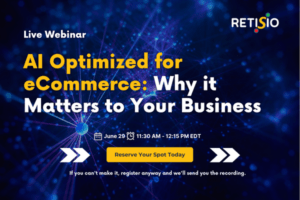RETISIO: Well, good day and welcome to RETISIO’s Unlock Digital Commerce Podcast. This is the show where we explore the latest trends in technology in the fast-moving world of digital commerce.
In this interview-style podcast, we ask the important questions to digital commerce practitioners and retail leaders to help you gain traction and sell more online.
Today we are excited to have Matt Hudson on the podcast with us. Hi Matt. Thanks for being here.
Matt Hudson: Hey guys. Thanks for having me.
RETISIO: Matt is an expert mobile app designer in the retail digital commerce space, and has led several high profile consumer facing mobile app implementations for large retailers and brands.
Matt has recently launched his own mobile commerce platform called BUILDIT, which enables e-commerce brands to quickly build mobile apps. Welcome, Matt. We appreciate you being here again.
And then as always, we have Tony Moores, who is lending his insight and expertise into all things digital commerce.
Tony is currently the chief technology officer at RETISIO and has a long track record of leading retailers and brands and digital commerce technology implementations. Welcome back Tony.
Tony Moores: Hey, thanks for having us and thanks for joining us, Matt.
Matt Hudson: Yeah, thanks.
RETISIO: So thanks again for being here guys. We have a great conversation in the store for our audience today.
Today we’re gonna discuss the world of mobile and digital commerce and try to capture some of Matt and Tony’s expertise on this important topic.
So, guys, several customers have asked us for recommendations on mobile apps as far as mobile first full. Should they go full native? Should they go Progressive web app?
There are all kinds of options and pitfalls I’m sure, and, and things they should watch out for along the way. What is, what is your advice for retailers and brands who need to get a great mobile experience accomplished most efficiently? And Matt, we’ll start with you.
Matt Hudson: Yeah, it’s, it’s a great question.
I think it’s one that I see a lot with companies that are trying to figure out how to determine: Do they need a mobile app? Do they need a progressive web app? What are the differences? What makes a great PWA? What makes a great mobile app?
Now, how do we get the costing right organizationally? How do we enable the team to be able to work?
Particularly with the dynamics of you know, different technology sets, even though they’re all very similar. So, you know, the answer that I have for people is kind of a, a few parts. First thing is, do I need a mobile app? Because I think it’s a very valid question. Now, of course, I think almost everybody needs a mobile app, but I’m obviously very biased.
But I think there is a decision-making framework that I like to give to people to decide because I think it’s undeniable that certain companies do not necessarily need a mobile app. So that framework is kind of like this. If I have a store I think you need a mobile app.
The reason why I say that is because store and mobile go together very well. If I’m coming to your store, I likely live near you and I can become a fan of you and I’m likely to come back. So if you have a physical brick-and-mortar storefront, I think it makes a lot of sense to have a mobile app, particularly if you’re a retailer with, you know, a certain number of stores.
The second way of determining is if you have a loyalty program. So if you have a loyalty program, you’re expecting people to come back multiple times often, and that makes a lot of sense. For mobile apps, that mobile app is your fan base. It’s people that want you on their home screen, that want to come back to see you.
Now, maybe not every one of your customers will have that app, but maybe 20, 30, 40, or 50%. And if you’ve got a younger customer, you know, maybe even 60% of your traffic.
For instance, Amazon, something like 60% of their traffic was mobile in their mobile app. Yet, you almost never see anybody open their web browser and type in amazon.com, right?
They either have the app or go there for marketing. They don’t open the browser and, and go to it. So if you got a loyalty program, you got a customer that comes back. Another way of thinking about it is the number of products you have, right? If you have one product, yeah. No reason to have a mobile app to display that one product, right?
But if you’ve got 10,000 products where you’ve got a customer that could potentially return to other things, then a mobile app makes a lot of sense. And then the very last way is just based upon there’s sort of a myth, but there is some truth to it, which is that older people don’t use phones or don’t use, you know, mobile apps.
It’s actually not true. The mobile app that I worked on for many years has more than 50 customers than 18 to 24-year-old customers. Which is mind-blowing because they have millions of users. Right? That’s a crazy number. But it is true that young customers don’t even realize that the web exists. They think everything is an app.
They don’t know Instagram has a website. Mm-hmm. They literally do not. In fact, I bet you guys don’t know if Instagram has a website yet. They do. But if you open the Instagram website up, when I clicked on that app icon, I’d be pretty annoyed. So if you got a younger customer, you almost have no choice because their expectation is if you don’t have an app, you don’t exist because their whole life has been there.
But you know, I think everybody has to have a PWA, so I actually don’t think it’s either or. I think PWA is table stakes and everybody should have PWA, but I also think they should have a mobile app. Oh, I’m sorry. Real quick for this, for the layman in the group.
Yeah. Well, Tony’s gonna talk about it a lot. I have a sneaky suspicion. Ok. But it’s the answer to the progressive web app, which basically just means that if the browser supports it, it will give you a very advanced, fast version of the mobile web. Gotcha. Which is better than responsive. Tony, what did I do, did I say correctly?
Tony Moores: No not at all. I mean, it’s funny because Brett’s question reminds me of, you know, I used to get, people used to come up to me and be like, you do computers, right? What kind of computer should I buy? And I would always answer with a question. I’d say, you know, how much do you know about computers?
And nine times out of 10, they’d say nothing. I’d say good, buy a Mac. And then, you know, if they did or I’d say, what, you know, what are you, what are you using it for?
Right. And so I’m, yeah, I’m, I really like the way you answered the question because, you know, it wasn’t about tech, it was about, you know, business drivers.
Right, right. And, you know, I, you know, to me, the definitive, you must have a mobile app comes down to do you have a plan or a strategy for connected versus a disconnected experience? Right? Because if the answer is yes, then, you know, let’s stop talking about it. Right? Because the only way to do I believe a good connected versus disconnected experience is really by going mobile native.
Yeah. Now, that being said you know, You can kind of start going that way with a PWA or a Progressive web app. Right. And, what’s the difference is it’s kind of you know, it’s kind of the shortcut to satisfy everybody at once. And usually, when you shoot for that, you end up kind of disappointing everybody at once if you don’t do it really, really well.
Yeah, absolutely. Yeah, cuz because these people have been asking this question, you know, back when people were saying things. , I gotta be able to support a client that doesn’t have JavaScript which of course you can’t, you know nobody asks that question anymore or says that anymore. So basically, a progressive web app is a web app that has little worker threads in the background that emulate some of the things that we take for granted that that, that live on our phones.
So for example, I mean HTML, and I always gotta chuckle out of, you know, here we are building a big industry about building stateful stuff on a stateless platform. But yeah, I mean, a mobile phone’s got memory, a mobile phone’s got a camera, a mobile phone has a GPS.
You know, your computer might have all of those things, but your browser does not, right? Web apps are built for browsers, and so PWA has basically you know, all, all of these hidden programs, demons services, if you like, threads that can do things like, oh, let me save stuff on your client so that I can load it up when it’s disconnected, or let me make a call to some other service to, you know, take some voice or, or place some audio or many things, right?
And, of course, the problem with PWA is how much you can and can’t do. How close you can come to emulating that mobile experience. Depends on which browser it’s run on. Absolutely. But the nice part about PWA is it’s a website at the end of the day. It’s a web app.
RETISIO: I was gonna ask, it also a website, too?
Tony Moores: Well, it’s a website and it’s an app because I can essentially save the website with an icon on my mobile screen. So it looks like an app, but I don’t have to go to an app store necessarily to download it. But it’s still a customer-facing website.
Tony Moores: Yeah. For, the layman, I would say look, if you’re old enough on the web to know what a bookmark is PWA is really just a great way to bookmark your webpage on an okay device.
RETISIO: That’s a good analogy. You always have the best analogies, Tony.
Matt Hudson: I think, the way I like to help people understand this in a way that makes sense to them visually and in their experience is if I go to a mobile app, I often have a tab bar, right? But if I’m on mobile web, PWA or not, that tab bar generally doesn’t exist, and there’s a reason why even though mobile apps are on a phone with similar technologies, something as simple as the tab bar is not a given on the web.
And there are a few reasons why that will help illuminate why what you were mentioning, Tony is an important service worker. The first thing is that the UI for the mobile app is all downloaded at once. Which I actually think is a huge advantage, and it is true that they have to go to the app store to download it.
And a lot of people say that is a negative thing about mobile apps, but I actually see it from the marketer’s angle, which is that if I’m not in the app store, I’m missing the marketing channel where I have an opportunity to be. And there are people searching for you in the app store, a lot of them, and you are missing it if you’re not there.
Not just if you have a young customer, but if you have an older customer too. So all of that being said, service workers allow us to do things in a mobile app that really makes the tab bar easy, right? So the beautiful thing about a mobile app is that if I pull it up, I can switch between all those tab bar screens and I never see a little loading spinner.
Because it loads all of it automatically, right? Mm-hmm, it’s downloaded with the app. It has an opportunity to make calls to the internet, and multiple API calls at the same time. But on the web, the paradigm is screened by a screen from the browser. And what that means is that it’s very, very hard.
Again, you asked the question who are you? Like, do you need a PWA? Part of the question is, do you have a team that can do it technically and strategically manage it, you know, as well as a mobile app or the other way around? And the reason why I bring that up is that if you’ve got a tech team that can build a tab bar with service workers that grab everything in the background, you could effectively build a PWA that has a similar experience as your app.
Now for me, I’m gonna say something offensive here. Somebody with tastes, it’s not gonna be good enough. Okay? But to an average person, it might be fine. But to build that tab bar, you need a really great web team. It’s not like just any, you know, any team can go build a really great single-page application that’s a PWA just because service workers exist and it also doesn’t.
mean that people are gonna bookmark it.
You know, Steve Jobs actually did not wanna make an app store. He wanted people to be able to bookmark websites because he actually believed this until he saw the value of the App Store. And now of course they make a ton of money on it and Apple supports it as the market.
Exactly.
But here’s the thing, why that’s important is because this technology has existed since iPhone, yet almost nobody even knows how to bookmark it on their phone, Google or iPhone. But they know the app store and they download apps. And even though maybe they don’t download a lot of apps as I do, they do download apps and they know how to, and so it’s a complicated thing.
On one hand, marketing is gonna go to your PWA unless you tie it to your mobile app, which I actually think is very important. that marketing is always gonna go to that super-fast experience, and that’s why I think PWAs table stakes because you have to give the customer the fastest possible experience you can deliver.
If they have the app open the app, if they have the web open, the best web experience you can have, and PWA gives them that.
Tony Moores: I’m glad you know you are worried about being offensive when you said you know, people with taste. Right. Because, because the same argument works in reverse, right? There are app factories out there, right?
Oh, for sure. And you can build a very dissatisfying, well, mobile native app. That’s true. Right? So this all comes down to like, Disney’s got Imagineers, like who’s managing your experience and who’s in charge of actually putting that together in a movie app.
Matt Hudson: The Costco app is a great example. It’s ranked number 19 in the App store, and it has a lot of web implementations inside its mobile app because they did it halfway.
They’re like, well, we need a mobile app. But then they built the web in it because they were lazy. And it’s like, guys, look, if you’re gonna do an app, do it right? And there are ways to bring web in that, that that can make sense, but it’s, again, you gotta have a sophisticated team to do that.
So Nordstrom is a great example. They have web components in their app, but they’re very fast, beautiful components that you can barely tell that they’re web, but they are. And if you’re not a technologist you can’t tell. So Costco’s a great example of here’s a company leaving millions of dollars on the table by having a web checkout and weird web experiences in a native app.
And it’s like, guys just pick. Okay. Either build a killer PWA, whatever, versus, you know, whatever you want to do, right? And, the killer beautiful front end with a great team and focus on it and let all your marketing go or build a great mobile app, put your marketing towards it. Put your efforts into it.
Use the human interface guidelines from Apple, the material design guidelines from Google, and do it right. Don’t try to take your team and then just transfer over all the web into your app. That’s not a great opportunity. Like, do a great site, and, or a great app, hopefully, both, because you’re gonna have people landing on your website.
But your biggest fans who spend the most money are gonna be using your mobile app.
And so people ask me, well do I need a mobile app? And I always say, well, do you need increased conversions? Do you need the people that spend the most to keep spending? You know, like, would you be mad if Starbucks didn’t have an app?
Yeah, you probably would if you like Starbucks. Cause I love mobile order, so why don’t those things apply to the big stores or, or big retailers?
You gotta, you gotta think about who am I and what kind of customers are looking for, you know, what I’m offering?
Tony Moores: Yeah, it comes down to use cases, right? Yeah.
So for example, right line busting? If you are in a queue waiting to get into an event, right? Someplace you don’t go too often, right? You probably don’t have it. Right, and if you are hoping to, to sell these people on a package as opposed to an admission by letting them line bust, then what do you really do, what is your real use case?
It’s got to load fast. Right? It’s gotta be easy to find. You can’t be goofing around with login, how big it is to log, you know, to log in, to fill in a form. Right? It’s gotta be stupid easy and stupid fast. Yeah. Right. To, for line busting. Right? It might be different for something else.
Matt Hudson: No, I actually think, I think that’s true for anything. You know, like people don’t wanna log in. I can’t tell you how many times a login has come up on a site that maybe I use a little bit, like, you know, like a place where I eat sometimes, but not all the time. And they ask me to log in and I’m like, no, I’ll go somewhere else. And it’s crazy because I just don’t want to type.
But literally that friction it, you know? Can you imagine if every time you opened up Instagram or Facebook or I don’t know, Chipotle or whatever it is you like you had to log in, you would be mad, you’d be like, no. So that’s like a very thing that people don’t realize. They hate logging in.
Tony Moores: And the thing that people who hate logging in don’t realize is every time they use a native mobile app, they’ve already logged in.
Matt Hudson: They have, you’re correct. I should say persistent login, right? Like once I’ve logged in once mm-hmm, and there’s like sandbox.
A lot of the technology guys don’t really understand it, cuz on the web you generally, the cookie’s gonna be gone or whatever. But in an app it’s a sandbox. So you don’t have to log in over and over again. And that just won’t ever change because of technology. And so apps will always have the huge advantage of, you know, not having to log in because it’s less of a security mechanism. But I agree with you, Tony, that like there’s a lot of, it depends there.
But I think it’s gotta be fast no matter what. Like I just think that no matter what the experience is, companies undervalue how frustrating it is for a customer to have to reenter a payment method or when the auto feels not there. or when my ZIP code doesn’t, as they do, they don’t quantify how many bugs exist on their website.
And how many small problems prevent people from buying? So, I really think that that’s actually a really big thing. I also say speed forgives bad UX.
I was on an airplane one time and the user interface for this system was really, And I pressed home and the UX wasn’t great, it just had some icons and I didn’t know what to press to get to movies, right?
It just kind of had a screen and it looked like a tv. So I clicked on it and it took like literally 10 seconds for that screen to load. And I was like, oh crap, that’s the wrong screen. And then I had to go back to home and the 10 seconds again, and I realized something right? Then if it was fast, that wouldn’t have mattered.
Because I could just switch. Boom boom, boom boom, fix the problem, right? But if it’s slow, I’m like bailing out like it. I mean, I was on the plane so I wasn’t bailing out, but you know what I’m saying.
Tony Moores: I think I might know what airline you were on.
Matt Hudson: You might, you might. But like if you give somebody that kind of bad experience in e-commerce, they’re leaving.
They’re gone, they can buy it on Amazon man, and Amazon’s gonna eat you for lunch if you are not giving them the fastest, most premium experience and it forgives your poor user experience if it is fast, and that’s true on the web app, tv, watch, whatever.
Tony Moores: Yeah, absolutely.
RETISIO: Cool. Well, so that kind of leads us to the next question. So should these, it is good advice there guys, but bottom line, should retailers, should they be worried more about their pocketbooks and doing it cheaply and quicker like you were mentioning, or should they really go for the big bang and look for a disruptive user experience and try to knock the ball out of the park?
Matt Hudson: That way I think, Tony, you go first. Tony, you tell ’em.
Tony Moores: Well, I mean, look, you can only launch once, right? So you can launch quietly or you can, you can launch loud, right? So look If you’re launching something because you’re behind and you’re trying to keep up with the Joneses you know, you have, you have to look at your, your own team and, and is, you know, what’s the, what’s the value in doing the work now?
I mean you know, who pulls out the Poor Richard’s Almanac or something, say anything that’s worth doing is doing well, worth doing well. Mm-hmm. So, you know, I would say like you, you, you should be shooting for full coverage, right? And, and Matt’s point is, you need ’em both, right? You need an app presence and all the big app stores, and you need a web presence for, you know, when you’re not on your device, right?
When somebody’s just like, Interacting with you on the fly. So, so, you know, what should they do? Depends a lot on where they are now. Right? I think, you know, gradually turning your site where people are already used to interacting with you into a PWA because you’re doing your own stunt. And maybe you don’t know anything about, you know, maybe you don’t have a mobile strategy that that’s gonna start taking you down the coverage area.
Yeah, it’s going to, and it is gonna start creating opportunities where your marketing folks, more than anybody you know, unless you’re actually listening to your customers are going to start providing use cases where you’re gonna say, yeah, I should really be doing, doing something mobile.
Matt Hudson: You are gonna get immediate benefits out of improving your web app, whereas a mobile app is a bit more challenging to build.
So, I agree with you, Tony. But I would, I would take it a little bit deeper, which is if I go into the mobile web and I put in service workers and Reactive and Webpack and all the cool stuff that makes, you know, I have already taken the steps to bring my team up to speed into modern technology sets, right? Maybe I have gone headless and I’ve got my API set up.
That is a logical first step to getting into the mobile app actually, because of the paradigms that make headless work. The whole point of headless is to be able to have multiple heads talking to this headless, right? Well, the mobile app is one of the heads. People talk about headless a lot, but then they only ever talk about one head.
And I’m like, well, what’s the point of headless if you’re not omnichannel having multiple heads? Like if you don’t have a kiosk, what do you know? So for me, headless is about having a kiosk, a web presence you know, APIs that talk to your store, scanners, a mobile app, et cetera. So to me, that’s what headless is really about.
It’s enabling all of those systems and understanding that there’s more than one front end to talk to, which is why you need to decouple it. But almost nobody ever talks about it, which I find hilarious. They’re like, well, it’s flexible. It’s like, yeah. But the point of it being flexible is, you know, to be able to have multiple heads.
So I think it’s a logical first step. You get your team in line, they understand mobile, and they learn about it. The marketing grows, and the budget grows. Then you say, okay, what’s the next step? Okay, well let’s find those people that love it, that are buying more on mobile web, and then let’s build them a mobile app.
Now you can start with iOS. You can start with Android. You probably should do both cuz there is a large number of users on both. But if you’re a big luxury retailer, you might only start with iOS. Because it’s a more affluent user. If you are, you know, a more of a, a discount store, you might, you know, do Android and iPhone together.
You may prioritize in that way. You may get an MVP out with a WebView checkout, although I don’t suggest it, but you might to get it out. Now the nice thing about mobile app is there is only one launch, and that’s true, but you do have an opportunity over time to launch to more people and grow it. So it starts small.
When you launch that mobile app, you actually don’t launch it to everybody. You only launch it to the people that download it. So you can do a pilot, you know, get 10,000, 50,000 users, market it, put in a beautiful native checkout, then blow it out, market it. Push it in the stores, and put up signage in the stores.
Now you’ve got a killer native checkout. You’re like, okay, now customers are demanding the native app be, have all the same features, right? Because once your users start using that, they’re like, well, why does the Web have features that the app doesn’t? Why can’t I pay my credit card on the web, but not in the app or whatever?
So you can build it that way, right? You can go, okay, let’s put in a PWA, let’s get our team up to speed. Let’s understand mobile, let’s do our marketing, and let’s build an app. Let’s build for iOS, build for Android. Then let’s market. You know, you don’t have to market on day one to your mobile app. You can market in a year, or two years.
Link your emails to the mobile app, then link your Google ads to the mobile app. So, I agree with you, Tony, that you know, you only get one launch and you gotta do it right. But I think that you can do an MVP, right? And then you can blow it out to more people and take a smaller, I mean, it’s not an incremental approach, but it’s like a step-by-step approach.
Tony Moores: Right? Well, you can only launch once to To the audience. To the user. Yeah. Right. You’re, I mean, you make a great point, right? Because like you. Well take that line-busting example, right? For if, if you do something on mobile specifically for line busting you don’t have to launch, right?
You could, yeah. You could literally stand up a sign at the far end of your queue in all your stores that say, don’t wanna be here, scan this QR code. And, now you’ve, you’ve just launched to an impatient person waiting in a long line.
Matt Hudson: Absolutely.
RETISIO: Awesome guys. Well, I appreciate the conversation and appreciate you being here, Matt. Awesome information. We’d love to have you back sometime so we can dig deeper into this topic and, and offer some more advice to these people. I loved how you called Costco out. I think we should do more of that.
Matt Hudson: Haha. I’ve done it many times and I feel bad. I just think they’re leaving millions of dollars on a table and I’m a Sam’s Club shopper, but I love Costco.
RETISIO: We’re telling you, you need to listen to this Costco, listen up.
Matt Hudson: Costco needs to do this. If they took their mobile app as seriously as they took their products, which are amazing and not marginally better, then they would have a much better mobile app. Okay? Because everything in Costco’s amazing. And I love Sam’s Club too.
Okay. I like both of them, but Sam’s Club app kicks Costco’s butt, but I’m not gonna lie.
RETISIO: Costco, you heard it air first on the Unlock Digital Commerce Podcast. That’s awesome. Yeah. That was awesome.
Tony Moores: Hey, Matt, if, if you come back I would love to unpack the whole omnichannel headless.
Yeah. You know, you should have already crossed that T and dotted that I before you even had the mobile conversation.
Matt Hudson: Absolutely. You know how many people I’ll come back. Let’s do it. Yeah. Okay. For sure. It’s awesome. I love semantic digression. for sure.
Tony Moores: Beautiful.
RETISIO: Thank you guys again for being here. It’s been awesome. Be on the lookout for the next episode of Unlock Digital Commerce Podcast. Be sure to also check out retisio.com for more resources and solutions to help you unlock digital commerce for your business. We’ll talk to you soon.







